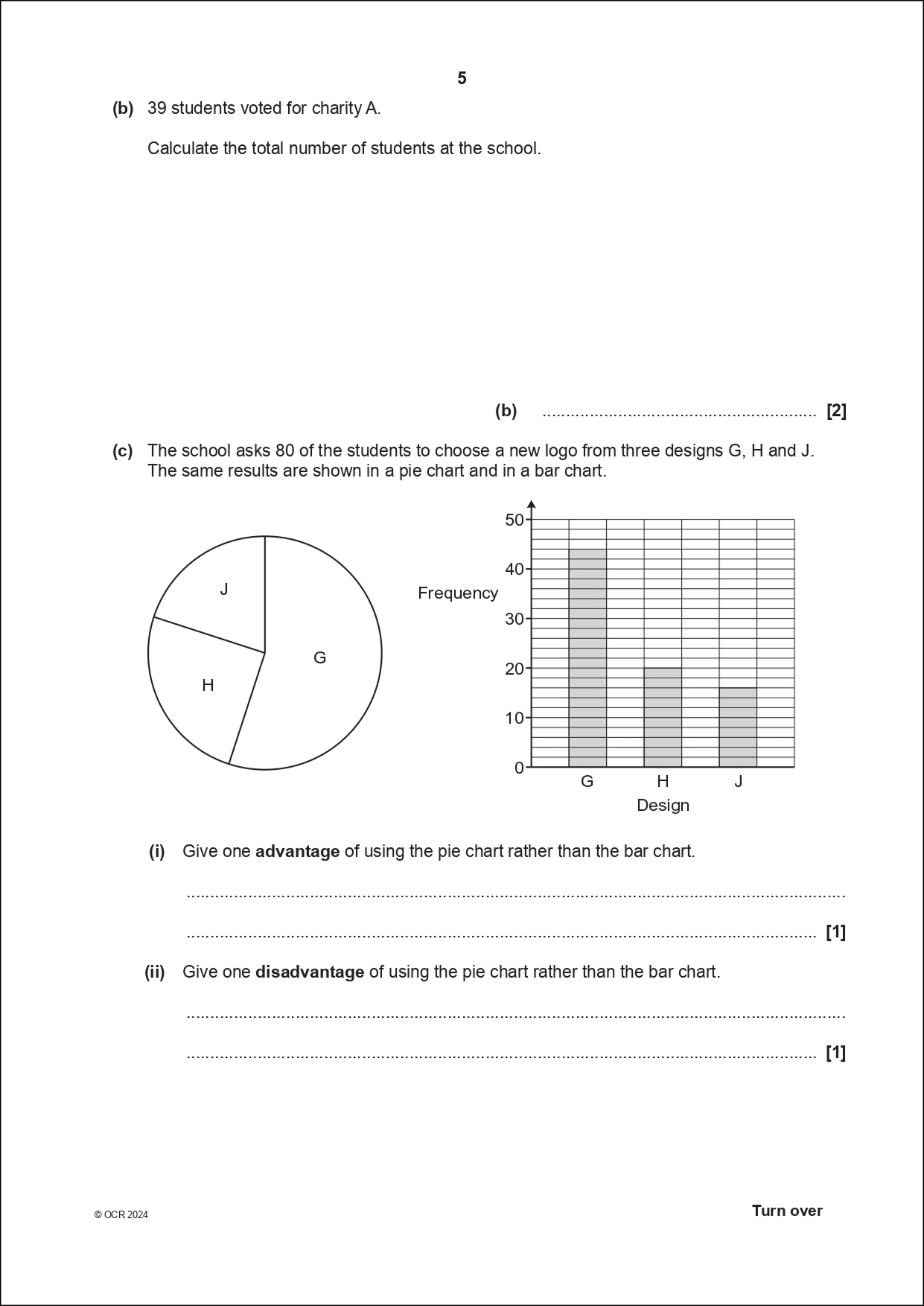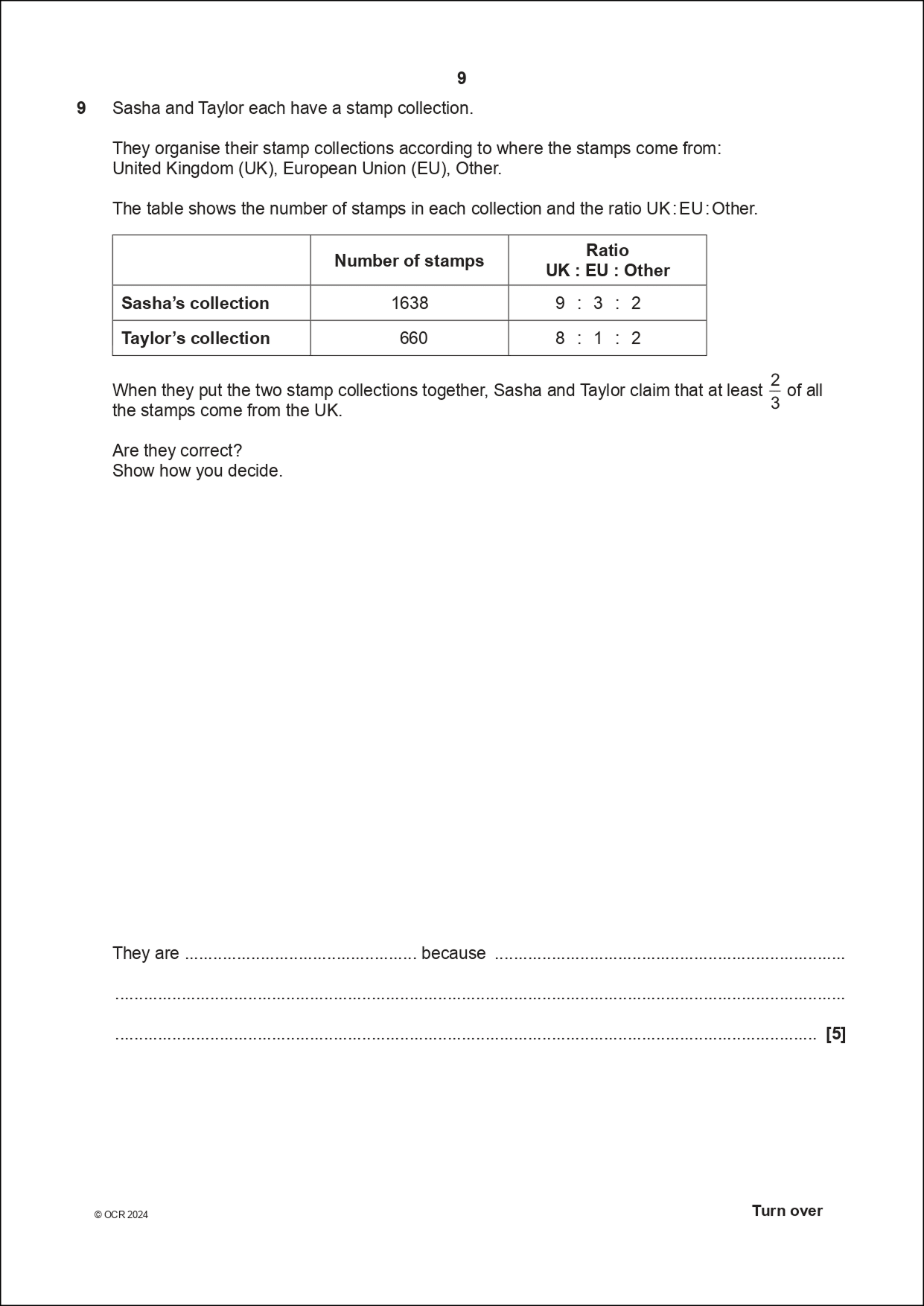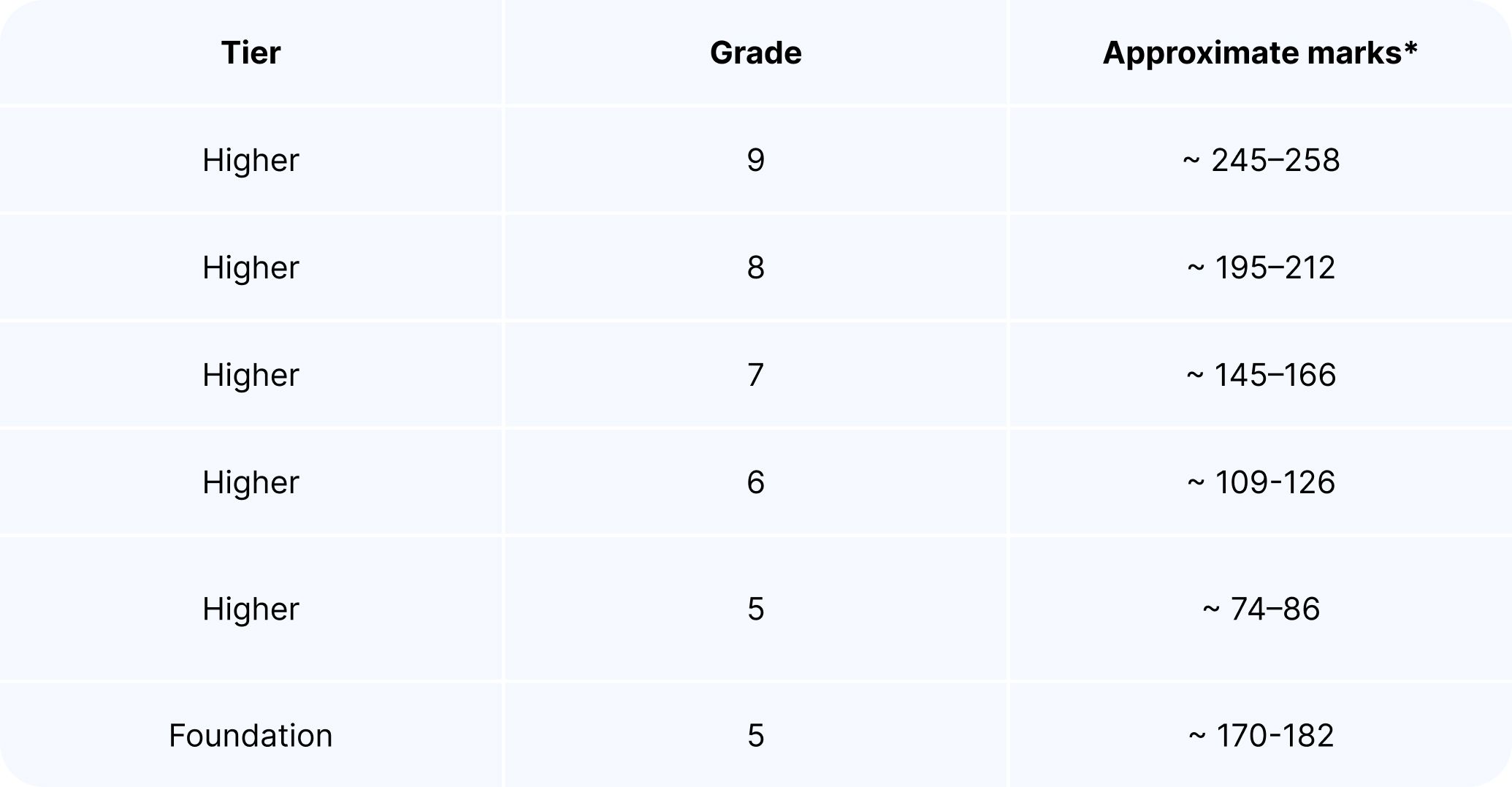Contents
Getting ready for OCR Maths GCSE? We’ve got everything you need to know to ace your exams.
Understanding what your tests will look like and how they’re graded is a great way to help with your revision and exam technique. This revision guide breaks down OCR Maths to show you how the exam is formatted, what grade boundaries to expect, what topics to revise and more.
Not sure which exam board your school uses? Take a look at our guide to finding out which exam board you’re studying.
Key takeaways:
There are three papers for OCR Maths GCSE, each 90 minutes long and 100 marks in total.
The grade boundaries for OCR Maths are set after the exams take place.
A formula sheet will be provided for Maths GCSEs in 2025, 2026, and 2027.
What’s the format of the OCR Maths GCSE?
Understanding the format of the paper and what to expect in your exam is essential for feeling confident and prepared on the day. Here’s a breakdown:
How many papers are there?
There are three exam papers for OCR GCSE Maths, for both the Foundation and Higher tiers.
You will take one non-calculator paper and two calculator papers.
Each paper lasts 90 minutes (1 hour and 30 minutes).
The total marks for each paper are 100, with a total score of 300.
All content from the OCR GCSE Maths course can be tested in any of the three exam papers, with questions often combining topics from across the curriculum.
Free revision timetable template & more
Less stress, more success! Get your free revision timetable templates and guide to effective revision today. Because great revision starts with a solid plan.
What’s the difference between Higher and Foundation for OCR Maths?
Like other exam boards, OCR splits its papers into a Higher and a Foundation tier.
Foundation tier OCR Maths:
Covers the essential topics such as Algebra, Geometry and Statistics that students need to know for further study, work, and everyday life.
In Foundation Maths, the highest grade you can achieve is a 5.
Higher tier OCR Maths:
The higher tier covers topics at a more advanced level, such as more complex Algebra, higher-level Geometry, and deeper Functions.
For Higher tier Maths, you can achieve up to a grade 9 - the highest grade possible.
Your school will place you in either the Foundation or Higher tier based on your Maths attainment in Year 9, although you can be moved up or down a tier during Years 10 or 11. You must take all three papers at the same level.
You can also take an additional Further Maths GCSE, which contains even more advanced topics. Check with your school to find out more.
What does the exam paper look like?
Each paper includes:
An instructions page: This is where you fill in their personal details and where you can read through the materials, instructions, information and advice for each OCR Maths paper.
The question booklet: This includes all the questions and where you will write your answers and show your working out.
Additional pages: These are for extra space to include working out, if needed. You must write the question number in the left-hand margin to ensure you don’t lose marks.
What kinds of questions are there?
For each of the papers, a mix of maths questions will appear. The difficulty increases as you progress through the paper.
Towards the start of the paper, short, one or two-mark questions will appear:

Pictured: Higher Tier, Paper 4 OCR GCSE Maths June 2024.
As you progress through the paper, multi-step problems with more marks will be included, requiring deeper thinking:

Pictured: Higher Tier, Paper 4 OCR GCSE Maths June 2024.
Each OCR GCSE Maths paper is worth 100 marks in total. The number of marks for a question shows how much detail or working is needed.
What are the grade boundaries for OCR Maths GCSE?
It’s important to remember that the exact grade boundaries for your GCSE exams will change every year. Exam boards adjust the grade boundaries after an exam has happened, depending on how advanced the exam content was and how the cohort performed.
This is so students don’t have an advantage or disadvantage because of the year they took the paper. For example, if your paper were harder, grade boundaries would be lowered so that a grade 5 reflects the same level of knowledge as in previous years.
We can’t tell you what the grade boundaries will be for OCR Maths in 2026. But we can take a look at previous years to get a sense of any patterns.
Below is a sample of Higher and Foundation boundaries for OCR to give a sense of the marks required for grades 7-9 and 5:

As you can see, grade boundaries can vary year on year by as much as 20 marks. But don’t worry - exam boards take care of making sure marking is done fairly.
Plus, if your results aren’t what you’d hoped for, you can ask for your paper to be remarked. But be careful, you can lose marks too when remarking!
As a reminder, take a look at our blog on how GCSE exams are graded.
Where can I find past papers and mark schemes?
Practising with OCR past papers and mark schemes is one of the most effective ways to prepare for GCSE Maths. Past papers help you understand the question style, see how marks are awarded, and build confidence with real exam timing and structure.
Head to the OCR website to find past papers and mark schemes from previous GCSE OCR Maths exams.
What key topics do I need to know for OCR Maths GCSE?
OCR Maths specifications set out a broad range of topics. You’ll need a thorough understanding of each to achieve top marks, so make sure you revise any areas you find tricky ahead of the exams.
The main topic areas from the OCR specification are:
Number: Includes calculations with integers, inverse operations and whole number theory.
Fractions, decimals, percentages: Includes topics like decimal fractions, ordering decimals, fractions and percentages.
Ratio, proportion, and rates of change: Includes calculations using ratio, direct and inverse proportion and discrete growth and decay.
Algebra: Includes topics such as expressions, equations, inequalities, sequences, and functions.
Indices and surds: Includes powers, roots, and exact calculations.
Basic Geometry: Including conventions, notation and terms, angles, circles and polygons.
Probability and statistics: Including sampling, analysing data and basic probability and experiments.
Approximation and estimation
Graphs of equations and functions: Includes straight line graphs and transformations.
Check out the OCR website for the full list.
These topics can appear in any of the three papers. For the non-calculator exam, it’s likely that topics such as simplifying, arithmetic, fractions, basic algebra and exact values will show up.
What are examiners looking for?
For OCR GCSE Maths papers, examiners aren’t just checking for the right answers; they want to see how you think. They’re looking for clear working, sensible explanations and answers that show genuine understanding of the questions.
Every question on the paper is written to show examiners what a student can really do. Each question tests one or more of the three Assessment Objectives (AOs), which we’ve laid out below to help you prepare.
The three assessment objectives are:
1. AO1 – Use and apply standard techniques
Students should be able to:
Accurately recall facts, terminology and definitions.
Use and interpret notation correctly.
Accurately carry out routine procedures or set tasks requiring multi-step solutions.
2. AO2 – Reasoning, interpreting and communicating
Students should be able to:
Make deductions, inferences and draw conclusions from mathematical information.
Construct chains of reasoning to achieve a given result.
Interpret and communicate information accurately.
Present arguments and proofs.
Assess the validity of an argument and critically evaluate a given way of presenting information.
3. AO3 – Solving problems in context
Students should be able to:
Translate problems in mathematical or non-mathematical contexts into a process or a series of mathematical processes.
Make and use connections between different parts of mathematics.
Interpret results in the context of the given problem.
Evaluate methods used and results obtained.
Evaluate solutions to identify how they may have been affected by assumptions made.
Every OCR Maths paper provides you with the opportunity to demonstrate what you truly understand. The best way to impress examiners is to approach each question step by step, show the working clearly, and check that your answers make sense.
By practising this approach regularly, you build the habits examiners look for: clear working, logical thinking, and confidence in tackling unfamiliar problems. It’s these skills, developed over time, that help turn preparation into strong, well-earned marks on exam day.
How can I prepare for OCR Maths?
To prepare for OCR Maths exams, you’ll need to start revising early to make sure you’re confident covering all the key topics. For exam revision tips, take a look at our Maths breakdown here.
What do I need to bring to the exam?
Feeling calm and prepared on exam day starts with having everything you need ready to go. For OCR GCSE Maths, what you’ll need for exam day depends slightly on which paper you’re sitting.
For Paper 1, you’ll need:
A black pen (bring a few spares!)
Pencil, ruler, rubber, and sharpener.
Protractor and compass for geometry questions.
For Papers 2 and 3, you’ll need everything above, plus a scientific calculator that meets exam board regulations. Make sure it’s in good condition with fresh batteries and that you’re confident using all its functions.
Finally, beyond Maths equipment, there are a few other essentials you’ll need for exam day:
Make sure to have a clear pencil case.
A bottle of water with no label.
If you’re wearing a school uniform, pack a jumper in case the exam hall is cold.
If your school allows non-uniform, choose clothes that feel comfortable and relaxed, so you can focus fully on the paper, not your outfit.
If you wear glasses, double-check they are packed the night before.
Bring any medications you may need, for example, your inhaler if you’re asthmatic.
Is there a formula sheet for GCSE Maths?
Yes! OCR provides a Formula and Tables booklet to all students during the exam. The DfE has confirmed that formula sheets will continue to be provided for Maths exams in 2025, 2026 and 2027.
This booklet will contain key formulas such as for area, volume, circle formulae, Pythagoras, and trigonometry and tables (e.g. statistical tables) that you are allowed to use in the exam. Take a look at the formula sheet for OCR 2025.
And that’s it - everything you’ll need to know to tackle OCR Maths GCSEs. Remember, proper preparation, including using practice papers and thorough revision, is the key to acing these tests.
Don’t miss Atom’s GCSE giveaway!

Six months. Six epic prizes. Six chances to make the GCSE season unforgettable.
We’re launching Atom for GCSE prep in 2026, and to celebrate, over the next six months, we’re giving away thousands of pounds worth of prizes to help your child level up their GCSE revision.
Here’s a taste of what’s up for grabs:
The latest Apple tech, including an iPad Air, Vision Pro and more
Festival tickets for Boardmasters and Reading 2026
Europe interrail passes and £1,000 spending money
…and that’s just a few of the amazing prizes available.
Our first two winners have already taken home incredible prizes! Find out who they are and what they won in our latest giveaway update and keep an eye out for news of our November winner.
It’s free to join. UK only. Full T&Cs apply.
Contents
